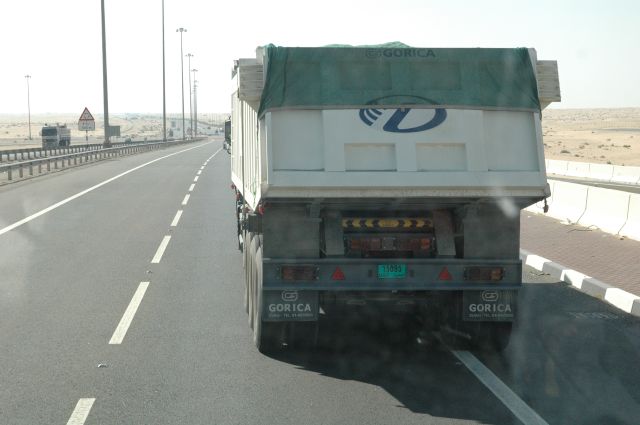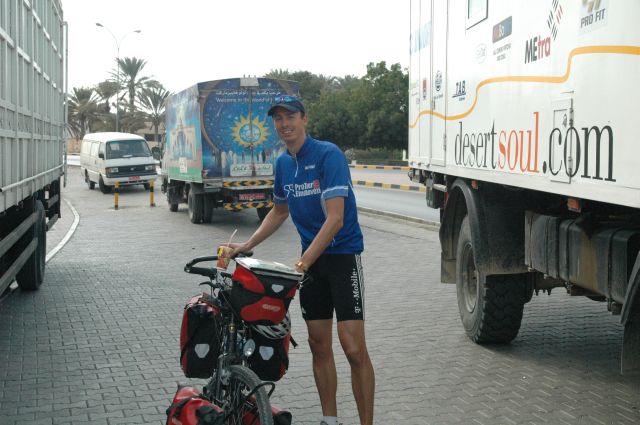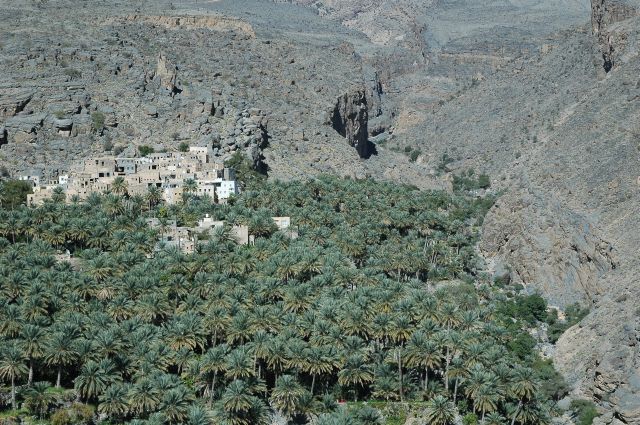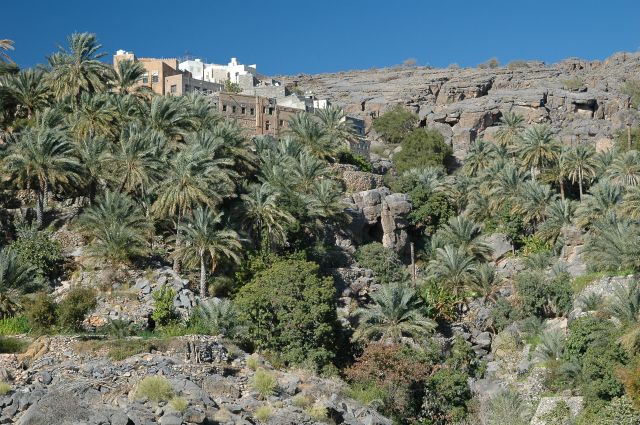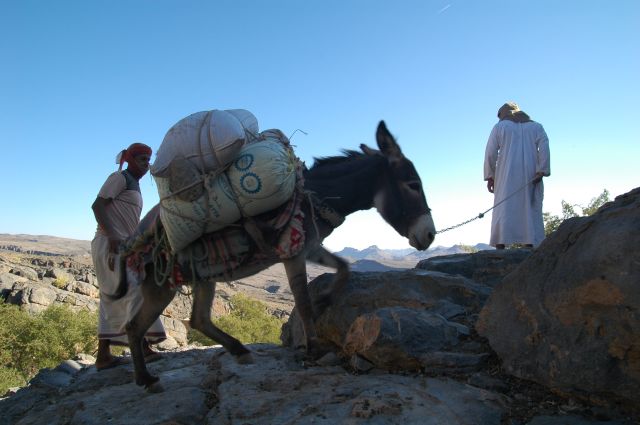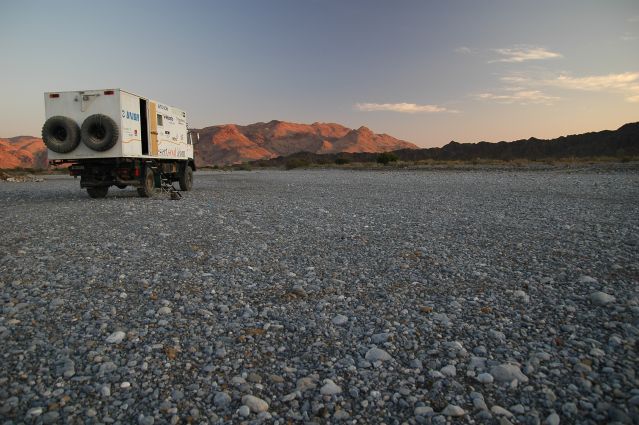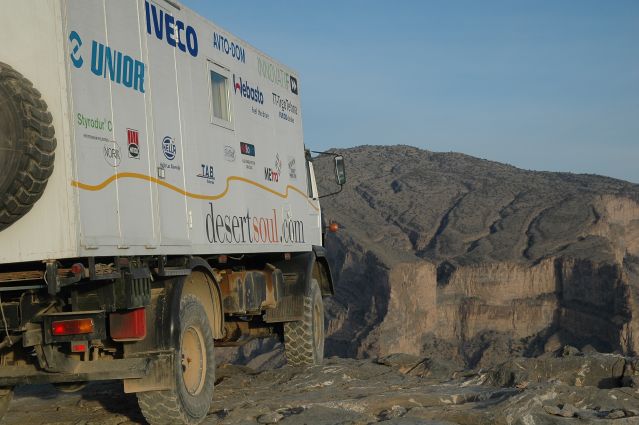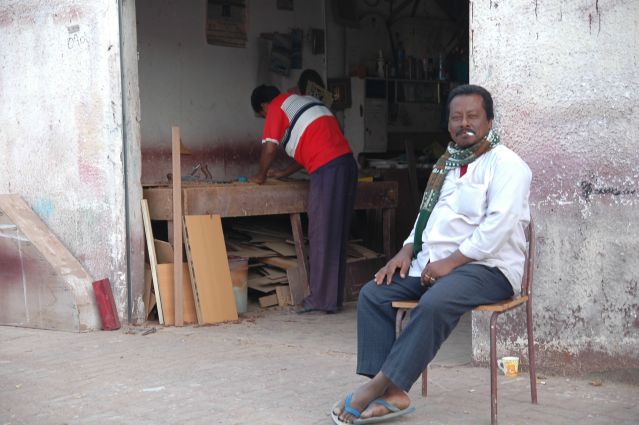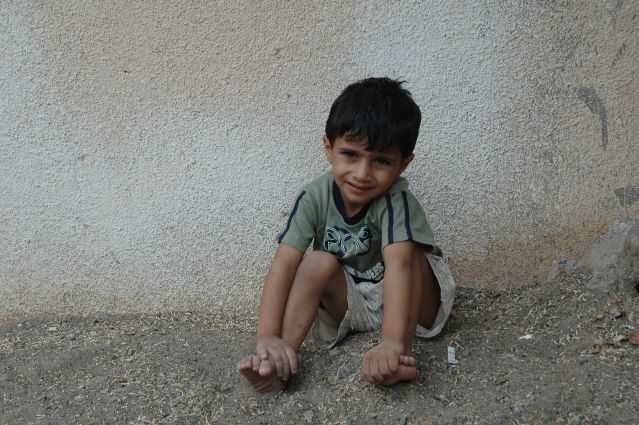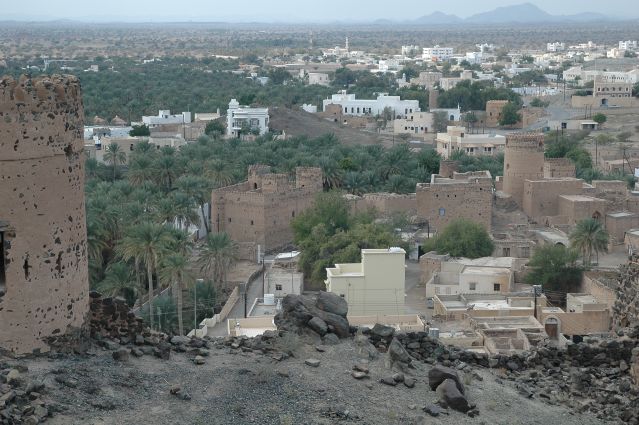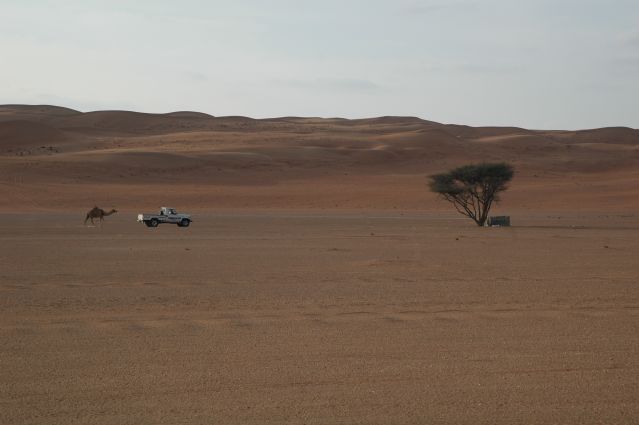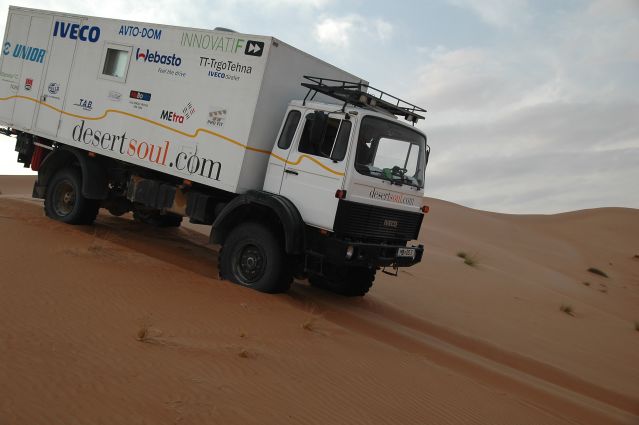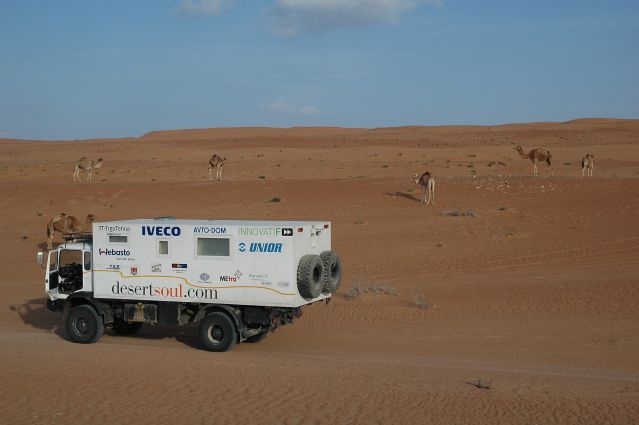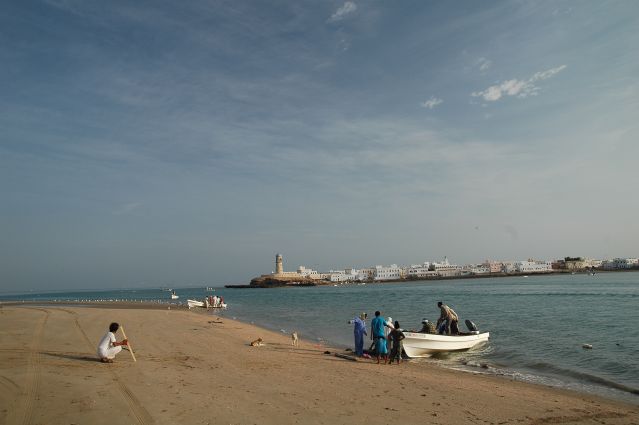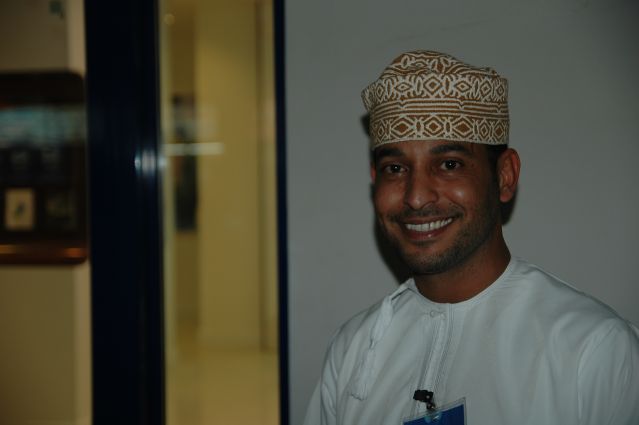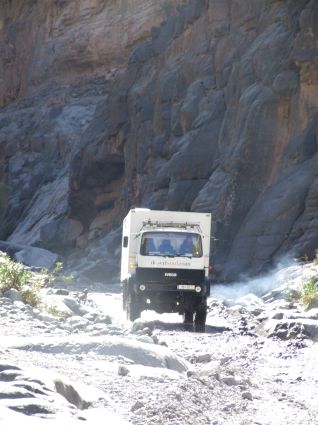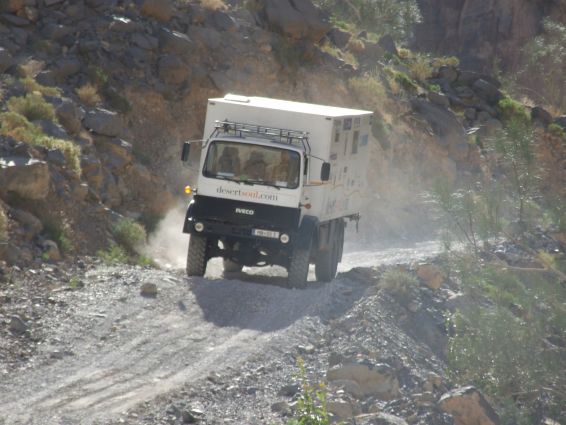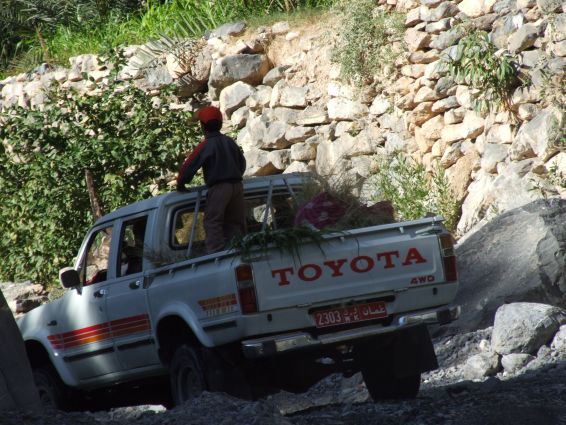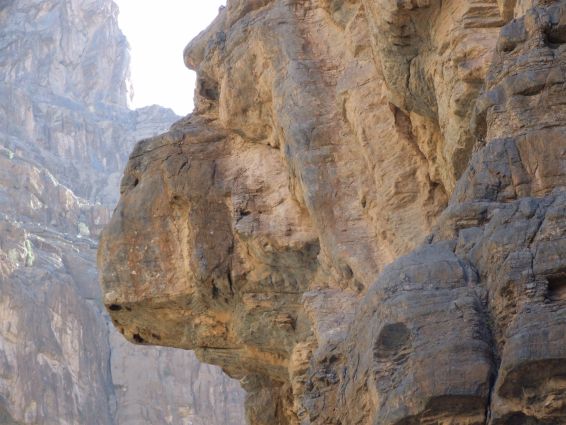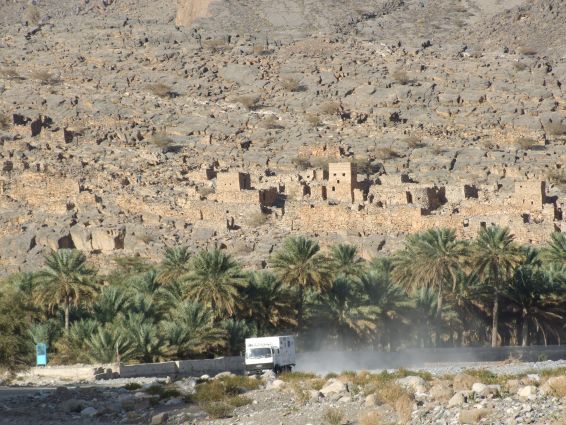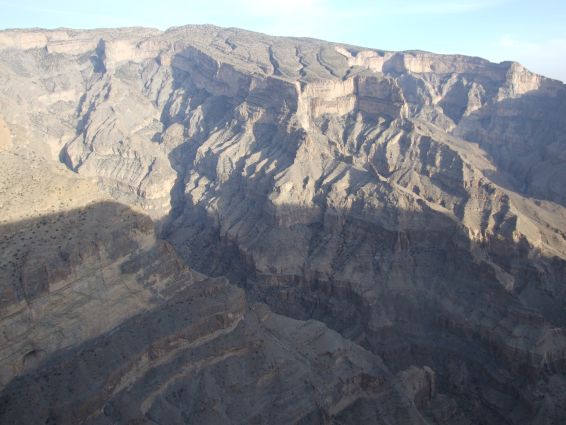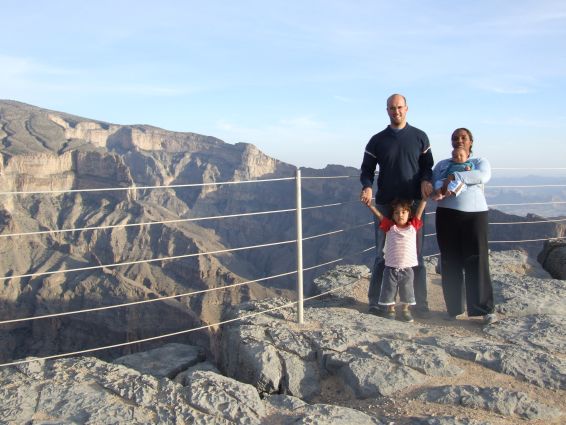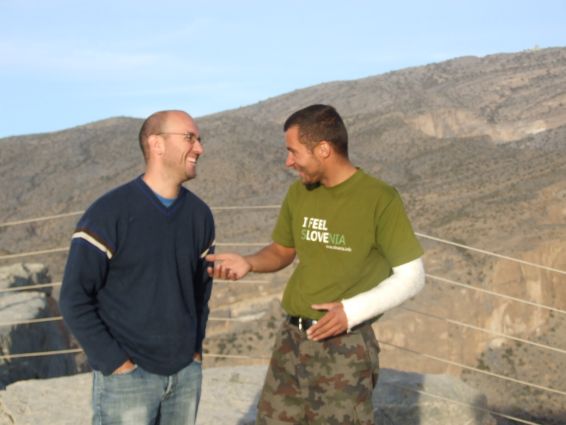GREETINGS TO GORICA AND MARIBOR
21.08.2015
Yes, I was right to think of ITAS when Carmen and I were passed in the Emirates by a tractor trailer with Gorica written on the side of the trailer. It would have been too big of a coincidence… When we later drove in the dark towards the coast south of Dubai to find a place to spend the night, we disappointingly discovered that we were driving towards a complex with high-rise hotels. But just before reaching them, we find that the lights are fixed to the tops of towers in an industrial park. As in a surreal fairytale, another familiar sign appears in a crossroads in front of us.
EM Hidromontaža. Dane has already mentioned that there was a Slovenian in Dubai working for Hidromontaža, and another one who was a representative for ITAS that manufactures trailers in Dubai under the trademark Gorica. The trailers are said to be swarming in Dubai, which I can now also confirm for Oman. Around a quarter of the trailers we came across were of the Gorica trademark.
Oman exists. Certainly! I am experiencing it rather intensely, as immediately after Carmen left, I switched into work mode. I am receiving a group at the end of the month (if I want the car to keep going, I’ll have to work), so I am now preparing both practically and theoretically for guiding them. Considering the rich history and outstanding geostrategic position of Oman, the theoretical part is extremely interesting, as a part of the history is linked to the Portuguese past. The practical discovery of the country is the most pleasant of course. I have spent the last few days in the "wilderness", so I was unable to report back to Slovenia. The landscape variety to be found in this country is stunning! And the point is that you will now scream with one voice: "But we have even more variety in Slovenia!" I know Slovenia (a bit less than would be appropriate), but I am now talking about Oman.
From the northern-most part of south-east Arabia, namely from the Straight of Hormuz, where Oman has an enclave on the Musandam peninsula and where Carmen and I have been travelling that day when tracing unfortunately didn’t work, the 3000 metre-high Jebel Akhadar mountains (the name simply meaning mountains made of stone) run along the Gulf of Oman and the Indian Ocean towards the south.. A few kilometres wide plain stretches between the sea and the mountains, where I found Sindbad’s town of Sohár. I will later be visiting Muscat (the pronunciation of the name of the Oman capital has finally been clarified – it is pronounced and written truly bizarrely, including the pronunciation sounding like the Slovenian word for the Muscatel wine. I have the clock on my legally bought, paid and installed Windows Vista set to that time – but I won’t be seeing neither the Muscatel nor Riesling or Merlot here). Wadis – dry river channels (well, not always dry as the photos that will follow later show) enabling in some places the crossing of the mountains – eat into the mountains from both sides.
And here’s where the journey that I always wanted to take begins. I often say that the strongest oriental influence can be felt in Morocco out of all the countries in the Middle East (please don’t reprimand me geographers as I have written it so on purpose). This orient is partly original and partly “newly composed” for the tourists there. But it is beautiful. It cannot be felt in Tunisia, and even less in Libya. And you will look for it in vain in Syria and Jordan as well. But you will find other magnificent things. Egypt? Perhaps. But it also lacks that... that... essence. The essence of the orient. The Emirates? Oooh, nooo.
Oman. It’s hot in January. Un point. When you crawl from the coast and look into the not-so-glittering interior, oases in mountain valleys surprise you along the way. Not true oases like those found in western Egypt or in the United Arab Emirates. 80 km in length and 20 wide. No. That which we see as an oasis. Nothing anywhere, and then a thick grove of palm tree in a small area, and a source, a woman washing clothes and camels. Deux points.
Elsewhere in Arabia (the term should be understood in the wider context), people dress almost as they do in Slovenia. Dark pants, shoes, shirt. In some places, they wear a dark sack that can have a hood over all of this. The first time I saw men actually wearing white robes called dishdash and scarves o their heads daily was in the Emirates. When I watched MBC, al-Jazeera or Rotana, the commercials always seemed funny to me. Toyota, Ariel, Pepsi, Pampers or Sensodyne. The men are always impeccably shaved and dressed in dishdash robes with a scarf, while the women are completely covered. It was like that in the Emirates. However, the locals who have to speak to the Indian workers at KFC in English – in their own country mind you – to get what they want are a minority. They are a rarity among the Indians, Pakis, Bengalis and the white and red westerners. Especially, because they are nicely tucked in their cars at 18 degrees Celsius and behind black-tinted windows, which gives them away as cars on four wheels and not ships. Someone honks the horn. Again. In a few moments, they “sit” on the horn. I look around. One of those giant white cows stands beside the sidewalk, with Toyota or Chevrolet or GMC probably written on it. You are dragging your feet again! An Indian waiter runs from the restaurant, the window opens slightly. The window closes, the waiter runs back. Hmm, interesting. I continue with my meal. The horn sounds again! What is wrong with you? Ah, the Indian is taking his time. He soon runs from the restaurant with bags and delivers them to the car. The car lingers a while. In a few minutes, the window opens again and the bags, plastic plates and other food packaging go flying out of the car and onto the sidewalk, and the car drives off. And I didn’t witness this kind of thing in the Emirates only. If someone honks the horn in Oman, the licence plate must be from Dubai or Abu Dhabi. In Oman, the people are truly dressed in white dishdash robes, only the head gear differs. Bedouins wear their usual scarves, while the other Omanis wear nice headgear called kumma. Trois points.
Just a stone’s-throw away from the sea and the mountains, there is sand. Real sand. There is a lot of it, and for some there is too much of it sometimes. Quatre points.
Wonderful wadis you can drive or walk in. A few days ago, I met with Lorraine Charles and her husband Daniel Simon in Nizwa. I didn’t really meet with them, but Cian (Kían, Irish name) and little Gavin were there. Lorraine contacted me, as you could already have read, through Jasna Pisanec, who will be bringing a group here at the end of the month. And we visited the supposedly second largest (highest, deepest, longest, the longest or just second, who’s to know) canyon in the world. Oh, the drive was... phenomenal! Cinq points.
Diving. Ah, I of course have to mention that I had my cast removed on Sunday (for the curious readers: I could not do exercise on a pommel horse even if I knew how to) and I got to work on the urgent repairs of the truck. To start, I replaced two of the four low beam lights with high beam lights. Gentlemen, ha ha, ladies and gentlemen, THIS is now what you call a light tunnel in front of the truck. When I was in Turkey and Iran, I at first couldn’t comprehend why the vehicles travelling in the opposite direction did not even "twitch" at my lights. Now, there is no one on the road who didn’t dip their beams when I drive past. But we have steered of course here. The topic is diving. At Ras al-Hadd (I still have to find out why it is called the iron garden) yesterday, I finally threw myself and the diving gear into the Indian Ocean. I went down 47 metres and saw 4 turtles, 2 dolphins and I escaped the bite of a barracuda by a hair. All of this would sound quite grandiose, but it would be far from the truth. 12 metres (the sandy bottom just won’t go deeper), many moray eels, one marble-yellow-black one, a metre and a half long and with its mouth open was pretty scary, especially because I initially thought that I was seeing a turtle’s leg under a rock. The blood red parrot fish, of which I saw a few in the Red Sea, swim in schools here. There is some coral, but I repeat, I jumped in the water blindly, just to feel the underwater world of the Indian Ocean. There are many sunken ships here and I am looking forward to diving to one of them in the following days. There won’t be any photos, not because of the poor visibility on account of the plankton, but because there was no money left for an underwater camera or a housing for a camera before I left Slovenia. Six points.
Would you like read more about turtles? Or about racing at full throttle across the desert? And collect the other half a dozen points? Stay on the line.
Translated from Slovenian by the Alkemist Translation Agency
#gallery0#gallery1#gallery2#gallery3#gallery4#gallery5#gallery6#gallery7#gallery8#gallery9#gallery10#gallery11#gallery12#gallery13#gallery14#gallery15#gallery16#gallery17#gallery18#gallery19#gallery20#gallery21#gallery22
EM Hidromontaža. Dane has already mentioned that there was a Slovenian in Dubai working for Hidromontaža, and another one who was a representative for ITAS that manufactures trailers in Dubai under the trademark Gorica. The trailers are said to be swarming in Dubai, which I can now also confirm for Oman. Around a quarter of the trailers we came across were of the Gorica trademark.
Oman exists. Certainly! I am experiencing it rather intensely, as immediately after Carmen left, I switched into work mode. I am receiving a group at the end of the month (if I want the car to keep going, I’ll have to work), so I am now preparing both practically and theoretically for guiding them. Considering the rich history and outstanding geostrategic position of Oman, the theoretical part is extremely interesting, as a part of the history is linked to the Portuguese past. The practical discovery of the country is the most pleasant of course. I have spent the last few days in the "wilderness", so I was unable to report back to Slovenia. The landscape variety to be found in this country is stunning! And the point is that you will now scream with one voice: "But we have even more variety in Slovenia!" I know Slovenia (a bit less than would be appropriate), but I am now talking about Oman.
From the northern-most part of south-east Arabia, namely from the Straight of Hormuz, where Oman has an enclave on the Musandam peninsula and where Carmen and I have been travelling that day when tracing unfortunately didn’t work, the 3000 metre-high Jebel Akhadar mountains (the name simply meaning mountains made of stone) run along the Gulf of Oman and the Indian Ocean towards the south.. A few kilometres wide plain stretches between the sea and the mountains, where I found Sindbad’s town of Sohár. I will later be visiting Muscat (the pronunciation of the name of the Oman capital has finally been clarified – it is pronounced and written truly bizarrely, including the pronunciation sounding like the Slovenian word for the Muscatel wine. I have the clock on my legally bought, paid and installed Windows Vista set to that time – but I won’t be seeing neither the Muscatel nor Riesling or Merlot here). Wadis – dry river channels (well, not always dry as the photos that will follow later show) enabling in some places the crossing of the mountains – eat into the mountains from both sides.
And here’s where the journey that I always wanted to take begins. I often say that the strongest oriental influence can be felt in Morocco out of all the countries in the Middle East (please don’t reprimand me geographers as I have written it so on purpose). This orient is partly original and partly “newly composed” for the tourists there. But it is beautiful. It cannot be felt in Tunisia, and even less in Libya. And you will look for it in vain in Syria and Jordan as well. But you will find other magnificent things. Egypt? Perhaps. But it also lacks that... that... essence. The essence of the orient. The Emirates? Oooh, nooo.
Oman. It’s hot in January. Un point. When you crawl from the coast and look into the not-so-glittering interior, oases in mountain valleys surprise you along the way. Not true oases like those found in western Egypt or in the United Arab Emirates. 80 km in length and 20 wide. No. That which we see as an oasis. Nothing anywhere, and then a thick grove of palm tree in a small area, and a source, a woman washing clothes and camels. Deux points.
Elsewhere in Arabia (the term should be understood in the wider context), people dress almost as they do in Slovenia. Dark pants, shoes, shirt. In some places, they wear a dark sack that can have a hood over all of this. The first time I saw men actually wearing white robes called dishdash and scarves o their heads daily was in the Emirates. When I watched MBC, al-Jazeera or Rotana, the commercials always seemed funny to me. Toyota, Ariel, Pepsi, Pampers or Sensodyne. The men are always impeccably shaved and dressed in dishdash robes with a scarf, while the women are completely covered. It was like that in the Emirates. However, the locals who have to speak to the Indian workers at KFC in English – in their own country mind you – to get what they want are a minority. They are a rarity among the Indians, Pakis, Bengalis and the white and red westerners. Especially, because they are nicely tucked in their cars at 18 degrees Celsius and behind black-tinted windows, which gives them away as cars on four wheels and not ships. Someone honks the horn. Again. In a few moments, they “sit” on the horn. I look around. One of those giant white cows stands beside the sidewalk, with Toyota or Chevrolet or GMC probably written on it. You are dragging your feet again! An Indian waiter runs from the restaurant, the window opens slightly. The window closes, the waiter runs back. Hmm, interesting. I continue with my meal. The horn sounds again! What is wrong with you? Ah, the Indian is taking his time. He soon runs from the restaurant with bags and delivers them to the car. The car lingers a while. In a few minutes, the window opens again and the bags, plastic plates and other food packaging go flying out of the car and onto the sidewalk, and the car drives off. And I didn’t witness this kind of thing in the Emirates only. If someone honks the horn in Oman, the licence plate must be from Dubai or Abu Dhabi. In Oman, the people are truly dressed in white dishdash robes, only the head gear differs. Bedouins wear their usual scarves, while the other Omanis wear nice headgear called kumma. Trois points.
Just a stone’s-throw away from the sea and the mountains, there is sand. Real sand. There is a lot of it, and for some there is too much of it sometimes. Quatre points.
Wonderful wadis you can drive or walk in. A few days ago, I met with Lorraine Charles and her husband Daniel Simon in Nizwa. I didn’t really meet with them, but Cian (Kían, Irish name) and little Gavin were there. Lorraine contacted me, as you could already have read, through Jasna Pisanec, who will be bringing a group here at the end of the month. And we visited the supposedly second largest (highest, deepest, longest, the longest or just second, who’s to know) canyon in the world. Oh, the drive was... phenomenal! Cinq points.
Diving. Ah, I of course have to mention that I had my cast removed on Sunday (for the curious readers: I could not do exercise on a pommel horse even if I knew how to) and I got to work on the urgent repairs of the truck. To start, I replaced two of the four low beam lights with high beam lights. Gentlemen, ha ha, ladies and gentlemen, THIS is now what you call a light tunnel in front of the truck. When I was in Turkey and Iran, I at first couldn’t comprehend why the vehicles travelling in the opposite direction did not even "twitch" at my lights. Now, there is no one on the road who didn’t dip their beams when I drive past. But we have steered of course here. The topic is diving. At Ras al-Hadd (I still have to find out why it is called the iron garden) yesterday, I finally threw myself and the diving gear into the Indian Ocean. I went down 47 metres and saw 4 turtles, 2 dolphins and I escaped the bite of a barracuda by a hair. All of this would sound quite grandiose, but it would be far from the truth. 12 metres (the sandy bottom just won’t go deeper), many moray eels, one marble-yellow-black one, a metre and a half long and with its mouth open was pretty scary, especially because I initially thought that I was seeing a turtle’s leg under a rock. The blood red parrot fish, of which I saw a few in the Red Sea, swim in schools here. There is some coral, but I repeat, I jumped in the water blindly, just to feel the underwater world of the Indian Ocean. There are many sunken ships here and I am looking forward to diving to one of them in the following days. There won’t be any photos, not because of the poor visibility on account of the plankton, but because there was no money left for an underwater camera or a housing for a camera before I left Slovenia. Six points.
Would you like read more about turtles? Or about racing at full throttle across the desert? And collect the other half a dozen points? Stay on the line.
Translated from Slovenian by the Alkemist Translation Agency
#gallery0#gallery1#gallery2#gallery3#gallery4#gallery5#gallery6#gallery7#gallery8#gallery9#gallery10#gallery11#gallery12#gallery13#gallery14#gallery15#gallery16#gallery17#gallery18#gallery19#gallery20#gallery21#gallery22
